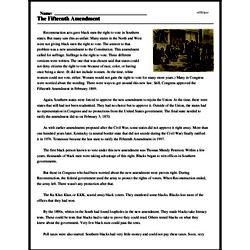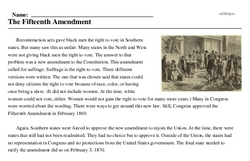The Fifteenth Amendment
Reconstruction acts gave black men the right to vote in Southern states. But many saw this as unfair. Many states in the North and West were not giving black men the right to vote. The answer to that problem was a new amendment to the Constitution. This amendment called for suffrage. Suffrage is the right to vote. Three different versions were written. The one that was chosen said that states could not deny citizens the right to vote because of race, color, or having once being a slave. (It did not include women. At the time, white women could not vote, either. Women would not gain the right to vote for many more years.) Many in Congress were worried about the wording. There were ways to get around this new law. Still, Congress approved the Fifteenth Amendment in February 1869.
Again, Southern states were forced to approve the new amendment to rejoin the Union. At the time, there were states that still had not been readmitted. They had no choice but to approve it. Outside of the Union, the states had no representation in Congress and no protections from the United States government. The final state needed to ratify the amendment did so on February 3, 1870.
As with earlier amendments proposed after the Civil War, some states did not approve it right away. More than one hundred years later, Kentucky (a neutral border state that did not secede during the Civil War) finally ratified it in 1976. Tennessee became the last state to ratify the Fifteenth Amendment in 1997.




